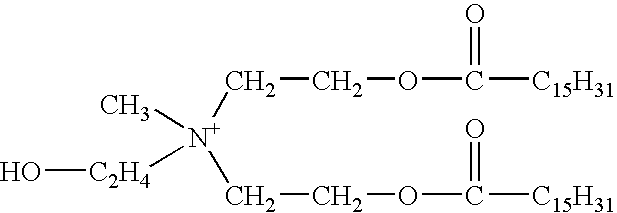Aqueous viscoelastic fluid
a viscoelastic fluid and fracturing fluid technology, applied in the direction of sealing/packing, transportation and packaging, borehole/well accessories, etc., can solve the problems of reducing the efficiency with which the fracturing fluid is removed from the propped fracture, and reducing the viscosity of the gel
- Summary
- Abstract
- Description
- Claims
- Application Information
AI Technical Summary
Benefits of technology
Problems solved by technology
Method used
Image
Examples
example 2
Relationship Between the Hydrophobicity of Esters and Compatibility with the Fluid
[0086] On FIG. 8 is plotted the viscosity of an aqueous gel containing 4.5 wt % surfactant (comprising 75 wt % N-erucyl-N,N-bis(2-hydroxyethyl)-N-me-thyl ammonium chloride and 25 wt % isopropanol), 0.75 wt % hydrophobically-modified polyacrylamide, 3 wt % NH.sub.4Cl and a dimethyl dibasic ester which can be dimethyl itaconate, dimethyl malonate, dimethyl malate, dimethyl oxalate, dimethyl glutarate, dimethyl adipate, dimethyl malonate or dimethyl azelate, as a function of the dibasic ester concentration, at 25.degree. C. The more hydrophilic dibasic esters, for example dimethyl itaconate, dimethyl malate and dimethyl oxalate are compatible with the gel even when present at 3-4 wt %.
[0087] The alkaline hydrolysis of dibasic esters is described by the following reaction:
R.sub.2OOC--Y--COOR.sub.2+2OH.sup.-.fwdarw..sup.-OOC--Y--COO.sup.-+2R.sub.-2OH
[0088] where R.sub.2 are alkyl groups and Y is a link grou...
example 3
Aqueous Viscoelastic Fluid Wherein the Second Surfactant is Erucyl Ester Methylene Dimethyl Ethyl Ammonium Chloride
[0092] On FIG. 9 is plotted the viscosity of aqueous gels comprising 2 wt % of a fluid (cationic surfactant) comprising 60.5 wt % N-erucyl-N,N-bis(2-hydroxyethyl)-N-methyl ammonium chloride, isopropanol and ethylene glycol, 4 wt % KCl and 0 or 0.5 wt % erucyl ester methylene dimethyl ethyl ammonium chloride as a function of shear rate, at room temperature.
[0093] It appears that erucyl ester methylene dimethyl ethyl ammonium chloride is compatible with a typical the N-erucyl-N,N-bis(2-hydroxyethyl-)-N-methyl ammonium chloride fluid. Its presence even actually enhances the initial viscosity of the gel.
[0094] The degradation kinetics of the above gel comprising 0.5 wt % erucyl ester methylene dimethyl ethyl ammonium chloride was then studied for various pH and at 25, 45 or 60.degree. C. Table 1 below illustrates the results that were obtained:
1TABLE 1 Degradation Time Degr...
example 4
Aqueous Viscoelastic Fluid Wherein the Second Surfactant is AMMONYX GA-90.TM.
[0097] On FIG. 11 is plotted the viscosity of aqueous gels comprising 4 wt % of a fluid (cationic surfactant) comprising 60.5 wt % N-erucyl-N,N-bis(2-hydroxyethyl)-N-methyl ammonium chloride, isopropanol and ethylene glycol, 4 wt % KCl and 0 or 0.1 wt % AMMONYX GA-90.TM. under a shear of 1 or 100 s.sup.-1, as a function of temperature and at pH equal to 6.3. AMMONYX GA-90.TM. is reasonably compatible with the gel. In the presence of 0.1 wt % of AMMONYX GA-90.TM., the gel has a lower viscosity in the temperature range up to 160.degree. F. (71.degree. C.) but a higher viscosity in the range 176-194.degree. F. (80-90.degree. C.). At high temperatures however, AMMONYX GA-90.TM. decomposes to the more hydrophilic tri(hydroxyethyl)methylamonium ion and palmitic acid. At the same time, the fluid pH evolves from 6.3 to around 3 and, under this acidic condition, palmitic acid is a hydrophobic species which efficient...
PUM
| Property | Measurement | Unit |
|---|---|---|
| phase angle | aaaaa | aaaaa |
| temperature | aaaaa | aaaaa |
| temperature | aaaaa | aaaaa |
Abstract
Description
Claims
Application Information
 Login to View More
Login to View More - R&D
- Intellectual Property
- Life Sciences
- Materials
- Tech Scout
- Unparalleled Data Quality
- Higher Quality Content
- 60% Fewer Hallucinations
Browse by: Latest US Patents, China's latest patents, Technical Efficacy Thesaurus, Application Domain, Technology Topic, Popular Technical Reports.
© 2025 PatSnap. All rights reserved.Legal|Privacy policy|Modern Slavery Act Transparency Statement|Sitemap|About US| Contact US: help@patsnap.com



